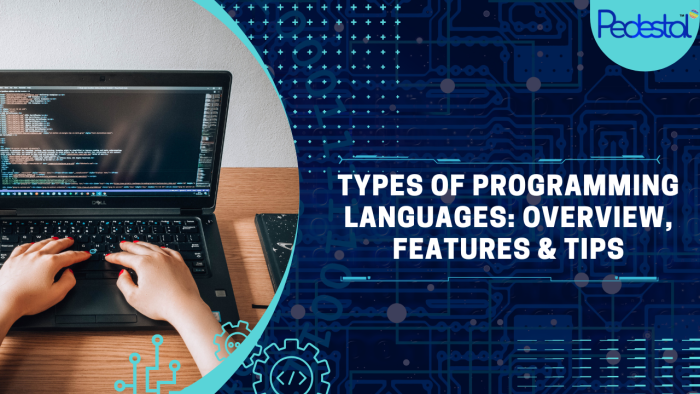Types of Programming Languages: Overview, Features & Tips

Posted by Seo Team Posted by Oct 16, 2024 in Skill development
Types of Programming Languages: Overview, Features & Tips
Programming languages are the backbone of the digital world, allowing us to build websites, apps, and even control complex systems. Each programming language has its own unique set of features and serves different purposes. In this blog, we'll explore the most common types of programming languages, their key features, and offer some tips on how to choose the right one for your needs. Whether you're just starting out or already have some coding experience, this guide will give you a solid understanding of the basics.
1. What Are Programming Languages?
A programming language is a set of instructions that tells a computer what to do. Just like we use languages to communicate with each other, programmers use different coding languages to communicate with computers. Each programming language has its own rules and syntax, allowing it to perform specific tasks.
Programming languages can be broadly divided into several categories based on their function and complexity. Let's explore these types in detail.
2. Types of Programming Languages
There are many types of programming languages, each with unique features and purposes. Here are the most common types:
a. Low-Level Languages
Low-level languages are closer to machine language, which is understood directly by computers. They are highly efficient but harder for humans to write and understand.
Machine Language (Binary): The lowest level, consisting of binary code (0s and 1s). It's extremely fast but difficult to program manually.
Assembly Language: A step above machine language, it uses symbols and text to represent code, making it easier for humans to write. However, it still requires detailed knowledge of the computer's architecture.
b. High-Level Languages
High-level languages are designed to be more user-friendly. They are easier to write, read, and maintain compared to low-level languages. Most modern programming languages belong to this category.
C, C++: These are powerful, general-purpose languages used for system programming, game development, and performance-critical applications.
Java: Known for its portability, Java is widely used in web development, Android app development, and enterprise applications.
Python: One of the most popular languages today, Python is loved for its simplicity and versatility. It’s used in web development, data analysis, AI, and more.
JavaScript: A must-know language for web developers. JavaScript is used for adding interactive features to websites. It’s essential in both front-end and back-end web development, especially in frameworks like Node.js.
c. Scripting Languages
Scripting languages are often used for automating tasks. They are typically interpreted, meaning the code is executed line by line, making them more flexible.
PHP: Popular for server-side web development, PHP powers many websites and content management systems like WordPress.
Ruby: Known for its elegance and ease of use, Ruby is used in web development, particularly with the Ruby on Rails framework.
Perl: A powerful scripting language used for text processing and system administration tasks.
d. Markup Languages
While not technically programming languages, markup languages are essential for structuring and presenting data.
HTML: HyperText Markup Language is used for structuring content on the web.
XML: Extensible Markup Language is used for storing and transporting data.
e. Database Languages
These languages are designed for managing and querying databases.
SQL: Structured Query Language is used for retrieving and manipulating data stored in relational databases.
3. Features of Programming Languages
Each programming language has its own set of features that make it suitable for different types of projects. Here are some common features to look for when choosing a language:
a. Ease of Use
Some languages, like Python, are designed to be simple and easy to learn. This makes them ideal for beginners. Languages like C++ and Java, while powerful, have a steeper learning curve.
b. Speed and Efficiency
Low-level languages like C and Assembly are known for their speed and efficiency, making them ideal for performance-critical applications. High-level languages might sacrifice some performance for ease of use.
c. Portability
Languages like Java are portable, meaning they can run on any platform that supports the language without modification. This is essential for developing cross-platform applications.
d. Community Support
Languages with large communities, like Python and JavaScript, have abundant resources, libraries, and frameworks that make development easier. Strong community support ensures you can find help when needed.
4. Tips for Choosing the Right Programming Language
With so many programming languages to choose from, it can be overwhelming to decide where to start. Here are some tips to help you choose the right one for your needs:
a. Define Your Goals
What do you want to achieve? If you're interested in web development, JavaScript, HTML, CSS, and frameworks like Node.js are essential. For mobile development, you might consider learning Java (for Android) or Swift (for iOS). If you're interested in data science, Python is a great choice.
b. Consider the Learning Curve
Some languages are more beginner-friendly than others. If you're just starting out, languages like Python and Ruby are excellent choices due to their simple syntax and strong community support.
c. Think About Job Opportunities
Look at the demand for programming languages in the job market. Languages like JavaScript, Python, and Java are highly sought after by employers. If you're pursuing a career in web development, knowing JavaScript is essential. For full-stack development, knowledge of both front-end and back-end languages is necessary. If you're in Jaipur, consider enrolling in the Full-Stack Web Developer Course in Jaipur offered by Pedestal Techno World to get hands-on experience with in-demand languages.
d. Stay Updated
The tech world is constantly evolving. Make sure to stay updated with the latest trends and languages. Learning new languages and frameworks can help you stay competitive in the job market.
e. Practice
No matter which language you choose, practice is key. Build projects, contribute to open-source communities, and continue improving your skills. The more you code, the better you'll become.
Conclusion
Programming languages are the foundation of the digital world, enabling us to build websites, apps, and much more. By understanding the different types of programming languages and their features, you can choose the right one for your needs. Whether you're looking to get into web development, mobile app development, or data science, there’s a language for you.
If you're interested in becoming a full-stack developer, consider enrolling in a full stack developer course in Jaipur to get hands-on experience with the latest programming languages and technologies. With the right skills and practice, you'll be well on your way to a successful career in tech.

